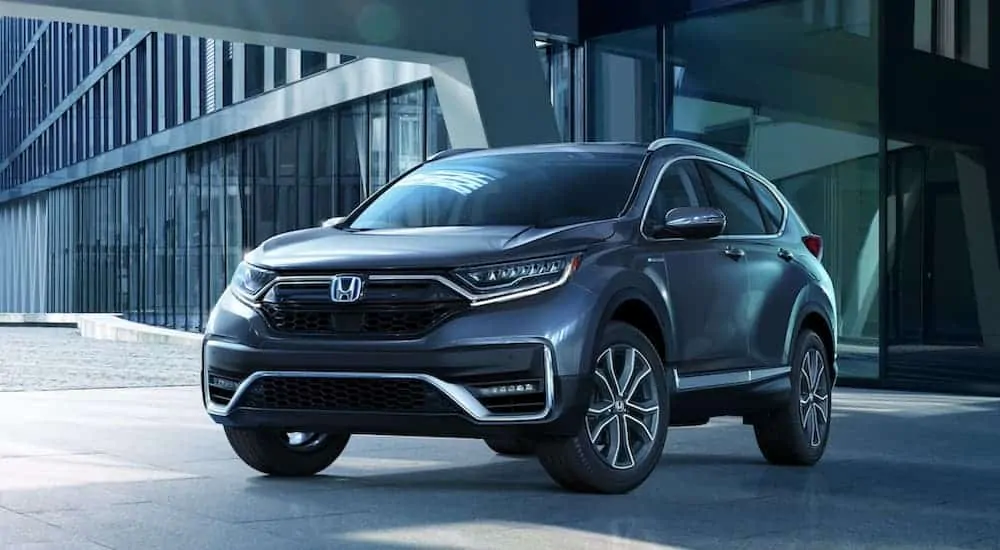A sporty, midsize SUV is a fine vehicle with a lot to offer if you’re on the market for such a thing––certainly not the type of ride that would go into battle with another vehicle. No, of course not. Except that’s exactly what’s happening here today! Once again, we pit two noble vehicles against each other in vicious combat of vehicular honor to see which one comes out on top. Today, it’s the 2020 Honda CR-V vs 2020 Ford Escape in an epic battle!
How will they each hold up? We’ll find out by looking at the kind of power they can each deliver, the sort of stamina they have (that’s their estimated fuel economy, just for the record), and how bulked up they are for combat––looking at size, particularly their interior volume. But real combat isn’t just about flashy attacks; we also want to see which model has the best defense: that means great safety features, not just available but standard.
Which vehicle will come out on top? Why do I compare midsize SUVs through combat metaphors? Who knows. Let us fight!
The Opening Charge – Power and Performance
The first to land a powerful blow is often the one that wins victory in combat, but that is not always the case. Nevertheless, we shall begin our furious bout by looking at the kind of power and performance these two vehicular gladiators can bring to the field. That means one thing: engines!
The 2020 Honda CR-V has two engines available: a standard one and a hybrid. The standard engine on the CR-V is a 1.5L turbocharged I-4 that offers up to 190 hp and 179 lb-ft of torque. If you choose the available hybrid engine instead, you get a 2.0L i-VTEC Atkinson-cycle engine that comes with an electric motor, putting out a total of 212 hp and up to 232 lb-ft of torque. That’s a pretty solid strike, and it comes with Real-Time all-wheel drive standard on hybrid models, with AWD available on the non-hybrid trims.
By comparison, the 2020 Ford Escape has three engines available, starting with a 1.5L EcoBoost that offers up to 181 hp and 190 lb-ft of torque––not bad, but not particularly stunning. Next up is a 2.0L EcoBoost engine that takes things quite a bit further thanks to 250 hp and 280 lb-ft of torque. Now we’re seeing some damage––this is decidedly much more power than the CR-V has to offer. Finally, there’s also a hybrid engine available for the Escape, providing up to 200 hp and 155 lb-ft of torque.
In terms of overall raw muscle, the 2020 Ford Escape brings in a devastating blow to get things started. But, if we’re looking at hybrids, I’d have to say the Honda CR-V offers a more furious opening attack. With Hybrids representing the future of automotive power, however, this as the attack that really catches my eye and pushes the CR-V into a strong, opening lead!
Stamina to Go the Distance
Normally, when you look at a midsize SUV like these two models, you don’t expect much in the way of impressive fuel economy. In battle, such a lack of stamina can mean the difference between the glory of victory and the bitter ashes of defeat. Since both the 2020 Honda CR-V and the 2020 Ford Escape have hybrid engines available, however, I expect them both to be able to stay on the field of combat much longer.
The standard engine in the Honda CR-V gets an EPA estimated 28 MPG in the city and 34 MPG on the highway, with a combined rating of up to 30 MPG. That’s with 2WD, of course, and the AWD fuel economy is just slightly lower. With the available hybrid engine, however, the 2020 Honda CR-V gets an estimated 40 MPG in the city, 35 MPG on the highway, and a combined 38 MPG total. Those are pretty solid numbers, especially for a midsize SUV, so how will the Escape respond?
Well, the standard 1.5L engine gives the 2020 Ford Escape an estimated fuel economy of up to 27 MPG in the city, 33 MPG on the highway, and 30 MPG combined. Slightly lower than the CR-V. With the available 2.0L engine, however, the Escape gets an estimated 23 MPG in the city and 31 MPG on the highway, which is much worse, though this is only available with AWD. Finally, the available hybrid engine delivers an estimated 44 MPG in the city, 37 MPG on the highway, and 41 MPG combined.
Looking at the numbers, you see more stamina in the 2020 Honda CR-V in terms of the standard engines, but the Ford Escape wins out when battling with the hybrids. I’m going to call this round a draw.
Cultivating Mass – Interior Volume
Now then, let’s see what kind of interior room these two titans of the auto industry bring to their epic conflict. Inside the 2020 Honda CR-V, you get a total of nearly 106 cu.ft. of passenger space available. For cargo, with the standard engine, the CR-V offers nearly 40 cu ft. of cargo space behind the rear seats and almost 76 cu.ft. of total cargo volume behind the front seats.
By comparison, the 2020 Ford Escape offers a total of 104 cu.ft. of maximum passenger space for you and your friends or family. The Escape has about 37 cu.ft. of available cargo space behind the second row of seats, and about 65 cu.ft. of total cargo volume behind the front row of seats. Keep in mind that shifting the seats can potentially reduce this amount of cargo space even more.
So, looking at these numbers, we see a clear and decisive victory for the 2020 Honda CR-V this round. With the CR-V, you get about 2 cu.ft. of additional passenger space, which is good but not mind-blowing. The real victory is in cargo space: you get about 3 cu.ft. of additional cargo space behind the second row of the CR-V and more than 10 cu.ft. of additional cargo volume behind the front row. That is a ton of extra space in the Honda CR-V compared to the Escape.
The Best Defense – Safety Features
Opening attacks and the ability to go the distance are great, but the best offense is, of course, a good defense. The 2020 Honda CR-V has some of the best standard safety features around; these include a lane keeping assist system, adaptive cruise control with low-speed follow, and auto high-beam headlights. You also get a forward collision warning, lane departure warning, collision mitigation braking system, and road departure mitigation system all standard in the Honda CR-V.
By comparison, standard safety features on the 2020 Ford Escape include AdvanceTrac with roll stability control and autolamp (automatic headlamps). Every model of the Escape also features pre-collision assist with automatic emergency braking, a blind spot information system, and cross-traffic alert. You get a lane-keeping system, post-collision braking, and a rearview camera all standard in the Ford Escape too.
I would have to say the defense round is another draw for these two worthy competitors. They both have truly impressive standard safety features.
Which Model Stands Victorious?
Now that the smoke has cleared, the dust has settled, and the battle is fought and won, who stands victorious? Honestly, this is an incredibly close battle and very nearly a draw––but a winner must be declared. These two powerhouses of automotive combat have stood proud, raining powerful blows upon each other, and lasted to the bitter end. Friends, car enthusiasts, people who have a weird fascination with descriptive vehicular battles: in the end, the 2020 Honda CR-V comes out on top, eking out a victory with its larger interior size.






